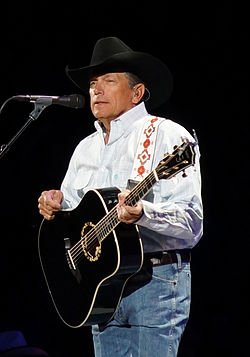Top Qs
Timeline
Chat
Perspective
List of best-selling music artists
From Wikipedia, the free encyclopedia
Remove ads
The following list of best-selling music artists includes musical artists from the 20th century to the present with claims of 75 million or more record sales worldwide. The sales figures are calculated based on the formula detailed below.
The tables are listed with each artist's claimed sales figure(s) and their total independently certified units and are ranked in descending order by claimed sales. If two or more artists have the same claimed sales, they are then ranked by certified units. The claimed sales figure and the total of certified units (for each country) within the provided sources include sales of albums, singles, compilation-albums, music videos as well as downloads of singles and full-length albums. Sales figures, such as those from SoundScan, which are sometimes published by Billboard magazine, have not been included in the certified units column.
Remove ads
Definitions
Summarize
Perspective
Gold and Platinum certifications issued after 2016, especially on singles, are in some cases more than 50% streaming generated. Some acts from the 20th century can also have significant amount of streaming based certifications. The certified units of the newer artists may sometimes be higher than their listed claimed figures. This is because Recording Industry Association of America (RIAA) and almost all other certifying bodies count streaming towards Gold and Platinum thresholds required for certification.[1][2][3] For this reason, some singles and even albums get over-certified by thousands of units. One such example is Rihanna's single "We Found Love", which was certified 9× Platinum by the RIAA in 2016,[4] but had sold only 5.4 million downloads at the time of the certification.[5]
The certified units for some artists/bands who have multi-disc albums can be higher than their listed claimed figures due to the RIAA counting each unit within a set as one unit toward certification. The certified units also can be inflated by the redundancy of certifications, because each of tracks downloads and streams contributed to the certifications of both of the single and the respective album. The RIAA counts 10 downloads of individual track as well as 1,500 audio/video streams as an equivalent to one unit of album, including those from singles released prior to the album release.[6] Theoretically, if one song were streamed 1.5 billion times on YouTube, the single would receive Diamond and the whole album could be certified Platinum,[7] thus creating a combined total of 11 million certified units without any sales. Kanye West's album The Life of Pablo achieved Platinum without selling a single copy and was only available for streaming.[8]
Issued certifications for songs which have been recorded by multiple artists including featured artists are added to each artist's total amount of certified units, as all the artists would have played a significant part in a song. For example, "This Is What You Came For" include Rihanna and Calvin Harris, while "Where Them Girls At" include Flo Rida and Nicki Minaj, so the certifications issued for these songs are added to the total amount of certified units for all involved artists. However, the certifications issued for songs that have been recorded by four or more artists are not included as the artists involved would have played minor roles, examples of such songs are Kanye West's "Monster" and "All Day".[a]
Standards
- The figures of total certified units within the tables below are based on certified units of albums, singles (including digital downloads) and videos.[9]
- The country order within the tables is based on the retail value they generate: the largest market is listed at the top and smallest at the bottom.[10]
- The column for certified sales includes markets, the databases of which contain certifications representing figures of 100,000 and more.
Remove ads
Artists by reputed sales
250 million or more records
200 million to 249 million records
120 million to 199 million records
100 million to 119 million records
80 million to 99 million records
75 million to 79 million records
Remove ads
See also
- List of best-selling albums
- List of best-selling singles
- Best-selling artists by nationality
- Best-selling artists by territory
- List of best-selling music artists in Brazil
- List of best-selling music artists in Finland
- List of highest-certified music artists in Germany
- List of best-selling music artists in Japan
- List of best-selling female music artists in the United Kingdom
- List of highest-certified music artists in the United States
- Best-selling artists by genre
- IFPI Global Recording Artist of the Year
Notes
- Below you can get an understanding as to when certifications for songs are added to the total certified sales of the listed artists.
- One lead artist and one featured artist. (The issued certification(s) should be added to the total of both, the lead artist and the featured artist as both will have almost equal amount of part).
- Two lead artists.(The issued certification(s) should be added to the total of both lead artists as both will have almost equal amount of part).
- Two lead artists and one featured artist. (The issued certification(s) should be added to the total of both lead artists as well as the featured artist. Both lead artists will play a significant part in a song and the part of the featured artist also should be significant enough).
- One lead artist and two featured artists. (The issued certification(s) should be added to the total of the lead artist and to the total of both featured artists as almost all should have equal amount of part).
- Certification systems have been established periodically throughout the past half century; thus, certification databases are not able to cover all sales. Some (or all) records released and sold prior to a certification system's establishment year may not be found within the available searchable certification databases. Year of establishment (from largest market to smallest based on Retail Value each market generates respectively):[9][10]
- United States: 1958[474]
- Japan: 1989[475]
- Germany: 1975[14]
- United Kingdom: 1973[476]
- France: 1973[477]
- Canada: 1975[478]
- Australia: 1997[19] (online certification-database has begun since 1997. Certifications; however, existed in Australia since the 1970s)
- Brazil: 1990[479]
- Netherlands: 1978[22]
- Italy: 2009[23] (online certification-database covers certifications issued since 2009. Certifications; however, have existed in Italy since the 1980s)[57]
- Spain: 1979[53]
- Sweden: 1987[26]
- Norway: 1993[27]
- Denmark: 2001[58] (online certifications for Denmark start from 2001. Certifications; however, existed in Denmark since the early 1990s[480])
- Switzerland: 1989[481]
- Mexico: 1999[482]
- Argentina: 1980[483]
- Belgium: 1995[484]
- Austria: 1990[37]
- Poland: 1995[38]
- Finland: 1971[485]
- Ireland: 2005[109]
- New Zealand: July 1978[40]
- Portugal:[42](online certification-database covers certifications issued since 2004. Certifications; however, have existed in Portugal since the 1980s)[57]
- United States[489] (Note, U.S. certification-award-levels for singles before 1989 were: 1,000,000 for Gold and 2,000,000 for Platinum.[490] Also, U.S. certification-awards for Shortform albums before September 1996 were: 250,000 for Gold and 500,000 for Platinum[491])
- Japan[492][493]
- Germany[494] (Note, German certification-award-levels for singles before 1988 were: 500,000 for Gold and 1,000,000 for Platinum.[495][496][497][77][57])
- United Kingdom[498]
- France[499][477][500][501]
- Canada[502] (Canadian certification-award-levels for singles before February 1982 were: 75,000 for Gold and 150,000 for Platinum[503])
- Brazil[504][505][506]
- Netherlands[507]
- Italy[23][508][509]
- Spain[510][511]
- Sweden[512]
- Norway[513][514][515][516][517]
- Denmark[480][518][519][520]
- Switzerland[481]
- Mexico[521][522]
- Argentina[483]
- Belgium[523][524]
- Austria:[523][525][526]
- Poland[527][528]
- Finland[485]
- New Zealand: (NZ certification-levels for singles before 1989 were: 10,000 for Gold, 20,000 for Platinum)[529](NZ certification-levels for singles before June 2007 were: 5,000 for Gold, 10,000 for Platinum)[530] (The levels for singles were adjusted again on June 17, 2016 from previous 7,500 for Gold, 15,000 for Platinum, to 15,000 for Gold, 30,000 for Platinum)[531]
- Portugal:[532]
Remove ads
References
Wikiwand - on
Seamless Wikipedia browsing. On steroids.
Remove ads






































